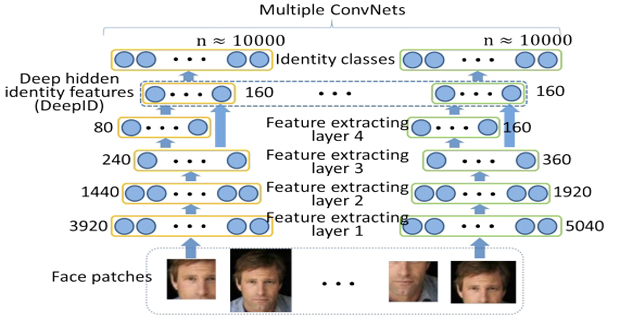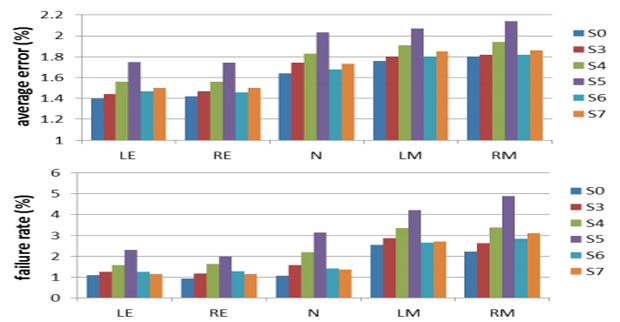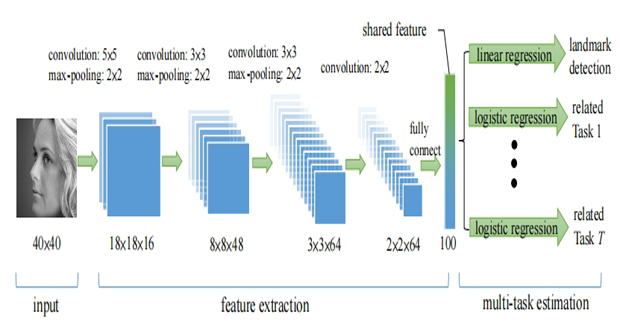-
 CVPRDeep Learning Face Representation from Predicting 10,000 Classes
CVPRDeep Learning Face Representation from Predicting 10,000 Classes时间:2014年丨作者:Yi Sun, Xiaogang Wang, Xiaoou Tang
This paper proposes to learn a set of high-level feature representations through deep learning, referred to as Deep hidden IDentity features (DeepID), for face verification. We argue that DeepID can be effectively learned through challenging multi-class face identification tasks, whilst they can be generalized to other tasks (such as verification) and new identities unseen in the training set. Moreover, the generalization capability of DeepID increases as more face classes are to be predicted at training. DeepID features are taken from the last hidden layer neuron activations of deep convolutional networks (ConvNets). When learned as classifiers to recognize about 10,000 face identities in the training set and configured to keep reducing the neuron numbers along the feature extraction hierarchy, these deep ConvNets gradually form compact identity-related features in the top layers with only a small number of hidden neurons. The proposed features are extracted from various face regions to form complementary and over-complete representations. Any state-of-the-art classifiers can be learned based on these high-level representations for face verification. 97.45% verification accuracy on LFW is achieved with only weakly aligned faces.
了解更多 -
 CVPRWIDER FACE: A Face Detection Benchmark
CVPRWIDER FACE: A Face Detection Benchmark时间:2016年丨作者:Shuo Yang, Ping Luo, Chen-Change Loy, Xiaoou Tang
Face detection is one of the most studied topics in the computer vision community. Much of the progresses have been made by the availability of face detection benchmark datasets. We show that there is a gap between current face detection performance and the real world requirements. To facilitate future face detection research, we introduce the WIDER FACE dataset, which is 10 times larger than existing datasets. The dataset contains rich annotations, including occlusions, poses, event categories, and face bounding boxes. Faces in the proposed dataset are extremely challenging due to large variations in scale, pose and occlusion, as shown in Fig. 1. Furthermore, we show that WIDER FACE dataset is an effective training source for face detection. We benchmark several representative detection systems, providing an overview of state-of-the-art performance and propose a solution to deal with large scale variation. Finally, we discuss common failure cases that worth to be further investigated.
了解更多 -
 CVPRDeepFashion: Powering Robust Clothes Recognition and Retrieval With Rich Annotations
CVPRDeepFashion: Powering Robust Clothes Recognition and Retrieval With Rich Annotations时间:2016年丨作者:Ziwei Liu, Ping Luo, Shi Qiu, Xiaogang Wang, Xiaoou Tang
Recent advances in clothes recognition have been driven by the construction of clothes datasets. Existing datasets are limited in the amount of annotations and are difficult to cope with the various challenges in real-world applications. In this work, we introduce DeepFashion, a large-scale clothes dataset with comprehensive annotations. It contains over 800,000 images, which are richly annotated with massive attributes, clothing landmarks, and correspondence of images taken under different scenarios including store, street snapshot, and consumer. Such rich annotations enable the development of powerful algorithms in clothes recognition and facilitating future researches. To demonstrate the advantages of DeepFashion, we propose a new deep model, namely FashionNet, which learns clothing features by jointly predicting clothing attributes and landmarks. The estimated landmarks are then employed to pool or gate the learned features. It is optimized in an iterative manner. Extensive experiments demonstrate the effectiveness of FashionNet and the usefulness of DeepFashion.
了解更多 -
 CVPRDeep Convolutional Network Cascade for Facial Point Detection
CVPRDeep Convolutional Network Cascade for Facial Point Detection时间:2013年丨作者:Yi Sun, Xiaogang Wang, Xiaoou Tang
We propose a new approach for estimation of the positions of facial keypoints with three-level carefully designed convolutional networks. At each level, the outputs of multiple networks are fused for robust and accurate estimation. Thanks to the deep structures of convolutional networks, global high-level features are extracted over the whole face region at the initialization stage, which help to locate high accuracy keypoints. There are two folds of advantage for this. First, the texture context information over the entire face is utilized to locate each keypoint. Second, since the networks are trained to predict all the keypoints simultaneously, the geometric constraints among keypoints are implicitly encoded. The method therefore can avoid local minimum caused by ambiguity and data corruption in difficult image samples due to occlusions, large pose variations, and extreme lightings. The networks at the following two levels are trained to locally refine initial predictions and their inputs are limited to small regions around the initial predictions. Several network structures critical for accurate and robust facial point detection are investigated. Extensive experiments show that our approach outperforms state-ofthe-art methods in both detection accuracy and reliability.
了解更多 -
 ECCVFacial Landmark Detection by Deep Multi-task Learning
ECCVFacial Landmark Detection by Deep Multi-task Learning时间:2014年丨作者:Zhanpeng Zhang, Ping Luo, Chen Change Loy & Xiaoou Tang
Facial landmark detection has long been impeded by the problems of occlusion and pose variation. Instead of treating the detection task as a single and independent problem, we investigate the possibility of improving detection robustness through multi-task learning. Specifically, we wish to optimize facial landmark detection together with heterogeneous but subtly correlated tasks, e.g. head pose estimation and facial attribute inference. This is non-trivial since different tasks have different learning difficulties and convergence rates. To address this problem, we formulate a novel tasks-constrained deep model, with task-wise early stopping to facilitate learning convergence. Extensive evaluations show that the proposed task-constrained learning (i) outperforms existing methods, especially in dealing with faces with severe occlusion and pose variation, and (ii) reduces model complexity drastically compared to the state-of-the-art method based on cascaded deep model
了解更多 -
 arXiv:1502.00873DeepID3: Face Recognition with Very Deep Neural Networks
arXiv:1502.00873DeepID3: Face Recognition with Very Deep Neural Networks时间:2015年丨作者:Yi Sun, Ding Liang, Xiaogang Wang, Xiaoou Tang
The state-of-the-art of face recognition has been significantly advanced by the emergence of deep learning. Very deep neural networks recently achieved great success on general object recognition because of their superb learning capacity. This motivates us to investigate their effectiveness on face recognition. This paper proposes two very deep neural network architectures, referred to as DeepID3, for face recognition. These two architectures are rebuilt from stacked convolution and inception layers proposed in VGG net and GoogLeNet to make them suitable to face recognition. Joint face identification-verification supervisory signals are added to both intermediate and final feature extraction layers during training. An ensemble of the proposed two architectures achieves 99.53% LFW face verification accuracy and 96.0% LFW rank-1 face identification accuracy, respectively. A further discussion of LFW face verification result is given in the end.
了解更多
